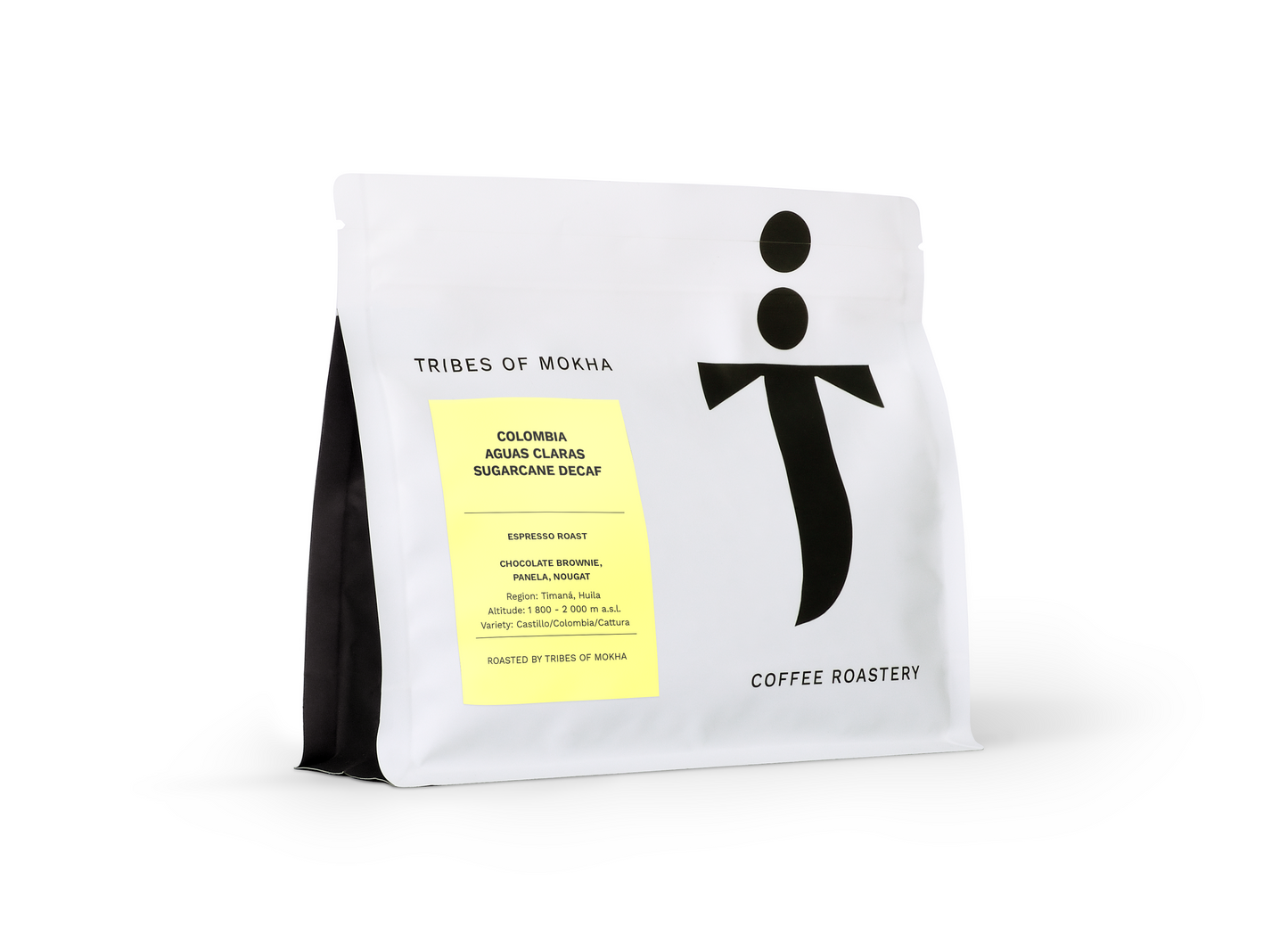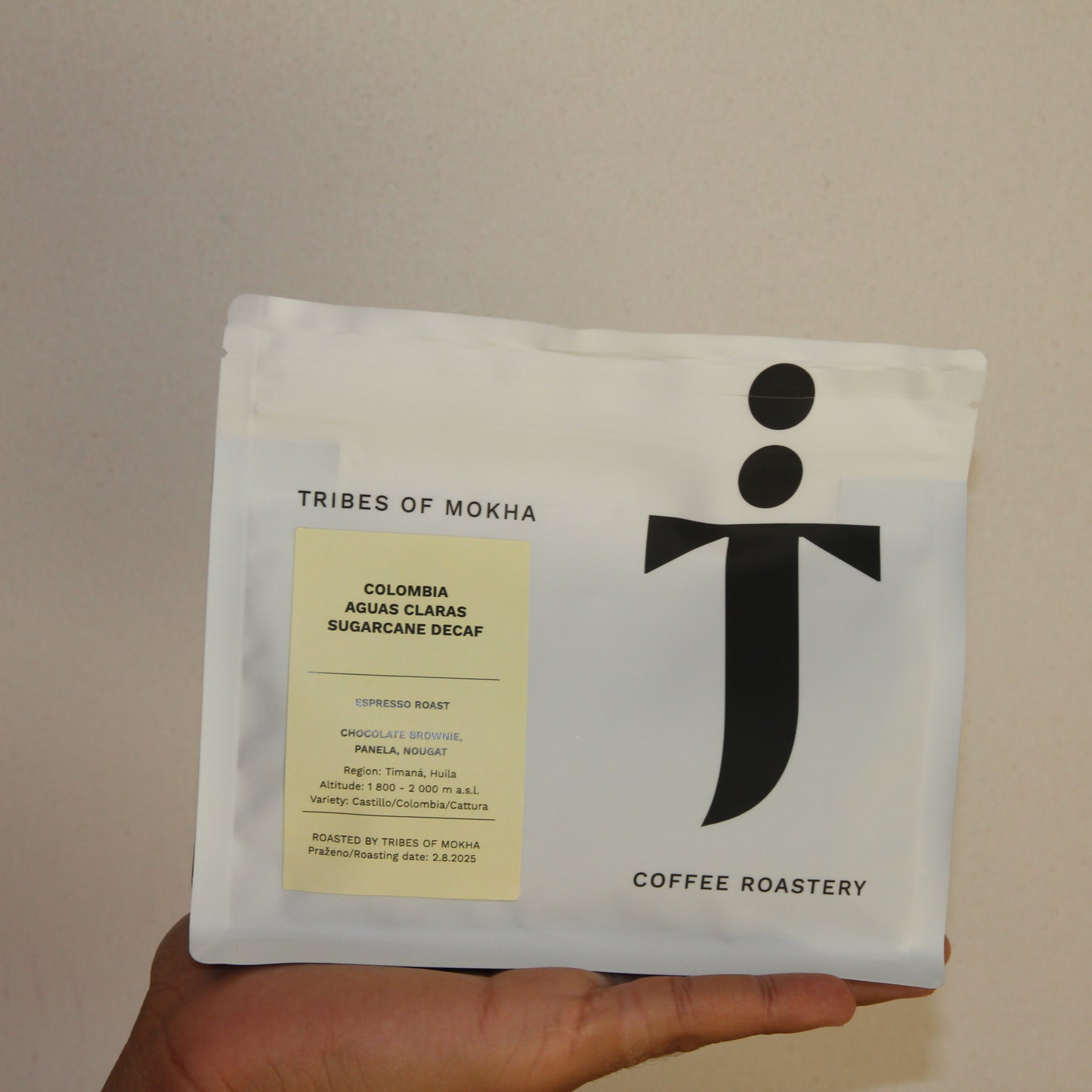Aguas Claras Decaf
Aguas Claras Decaf
COLOMBIA
REGION: Timaná, Huila
Altitude: 1 800 - 2 000 m a.s.l.
VARIETY: Caturra / Colombia / Castillo
PROCESS: Sugarcane Decaf
ROAST: Omni
ACIDITY: ● ● ● ● ●
BODY: ● ● ● ● ●
SWEETNESS: ● ● ● ● ●
Couldn't load pickup availability
LEARN MORE
LEARN MORE
Sourced from a cooperative in Timaná, southwest Colombia—a region nestled between the three arms of the Andes and nourished by the Magdalena River.
This lot is decaffeinated using the sugarcane process, a method that gently removes caffeine using naturally derived esters from local sugarcane. Of all the methods we’ve explored, this is the one that best preserves the coffee’s character—allowing its sweetness, clarity, and regional identity to shine through.
A decaf that tastes like the real thing.
PROCESS: SUGARCANE
Sugarcane decaf is processed using ethyl acetate (EA), a naturally occurring compound derived from fermented sugarcane. The method begins by gently steaming the green coffee beans to open their pores. The beans are then repeatedly washed in an EA solution, which selectively bonds with and removes caffeine while leaving flavour compounds largely intact. After extraction, the beans are rinsed and dried to their original moisture level, ready for roasting. This process—widely used in Colombia where sugarcane is plentiful—is prized for its ability to retain the coffee’s original sweetness, complexity, and body. The result is a decaf that tastes remarkably close to its caffeinated counterpart, with none of the bitterness sometimes associated with decaffeination.
VARIETY: CATURRA / COLOMBIA / CASTILLO
The Castillo and Colombia varieties are two cornerstone coffee cultivars developed by Colombia’s National Coffee Research Centre (Cenicafé) to combat coffee leaf rust while maintaining exceptional cup quality. Castillo, introduced in 2005, offers enhanced resistance, higher yields, and vibrant flavour profiles with notes of tropical fruits, citrus, and chocolate. Its predecessor, the Colombia variety, released in the 1980s, set the stage for sustainable coffee production with balanced acidity and red fruit undertones. Together, these rust-resistant hybrids have transformed Colombia’s coffee landscape, empowering farmers to produce specialty-grade coffee while ensuring resilience and sustainability.
TRACEABILITY:
TIMANÁ
Timaná Municipality, located in Colombia’s Huila Department within the upper Magdalena River Valley, is a region of dramatic landscapes and agricultural richness. Spanning 182.5 square kilometres, the municipality enjoys a temperate climate with an average temperature of 24°C, ideal for farming. Its economy is predominantly agricultural, with coffee as the primary crop. Known for its high-quality beans, Timaná is one of Huila's leading coffee-producing areas, supported by smallholder farmers. Additional crops like plantains, maize, and beans also contribute to the local economy. With a population of approximately 23,395, most residents live in rural areas, preserving Timaná's strong agricultural heritage.
HUILA
Huila, located in southern Colombia, is a region rich in history, culture, and coffee excellence. This department was originally home to indigenous groups such as the Pijao, Andaquí, Yalcones, and Paeces, whose cultural heritage is evident in the renowned San Agustín Archaeological Park. This UNESCO World Heritage site is one of Latin America’s most significant pre-Columbian archaeological locations.
Huila is one of Colombia’s most important coffee-producing regions, especially noted for its specialty coffees. The region’s unique combination of high altitudes (often ranging from 1,200 to 1,800 meters), volcanic soils, and a variety of microclimates creates ideal conditions for growing coffee with rich and complex flavour profiles. The department’s coffee received Protected Geographical Indication (PGI) status in 2013, underscoring its exceptional quality on the international stage. The local coffee industry consists mainly of small-scale farmers who continue to use traditional cultivation methods. For many families in Huila, coffee isn’t just a crop—it’s a way of life and a cornerstone of cultural identity.
Huila’s culture is deeply intertwined with music, dance, and vibrant celebrations. The Bambuco National Festival, held annually in Neiva, the department’s capital, celebrates Huila’s musical heritage with performances of bambuco—a traditional Andean rhythm—and the famous sanjuanero huilense dance.
The department’s geography is diverse, ranging from the high Andean peaks, like Nevado del Huila (one of Colombia’s tallest volcanoes), to the tropical valleys along the Magdalena River, Colombia’s longest river. The climate varies accordingly, with cooler temperatures in the highlands and warm, tropical conditions in the lowland valleys, which support a wide range of agricultural products including coffee, cacao, fruit, and rice. Huila also hosts the Tatacoa Desert, famous for its red and gray rock formations and its stargazing appeal, drawing visitors from around the world.
With its Protected Geographical Indication status, internationally recognized quality, and commitment to traditional farming methods, Huila stands as a beacon in the Colombian coffee landscape. Its rich cultural and environmental diversity not only supports an exceptional coffee-growing industry but also makes Huila one of Colombia’s most unique and intriguing regions.







